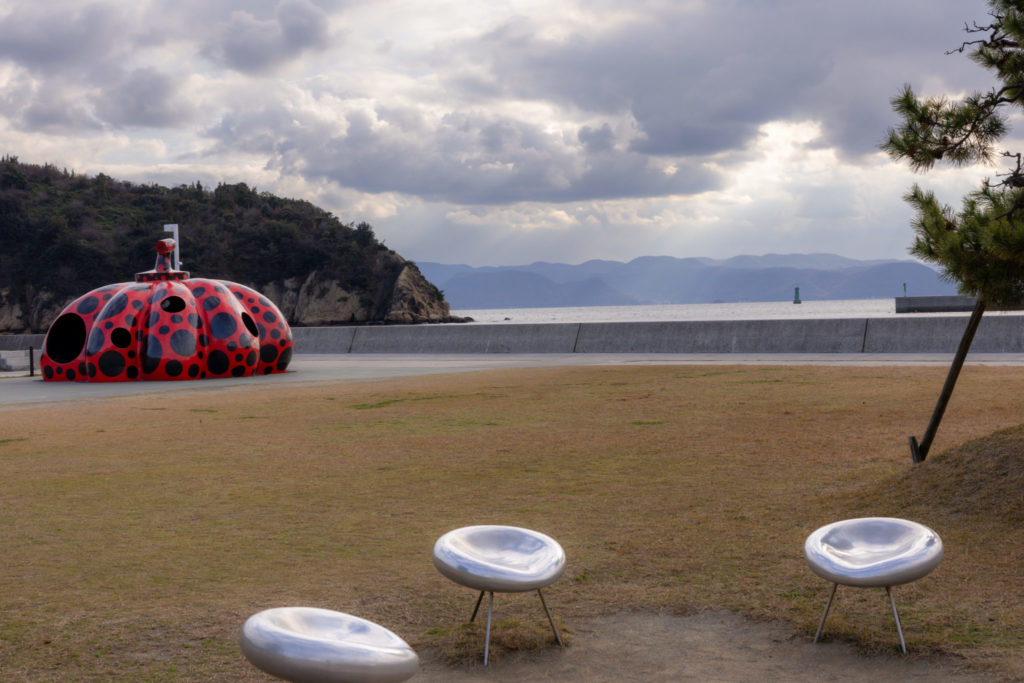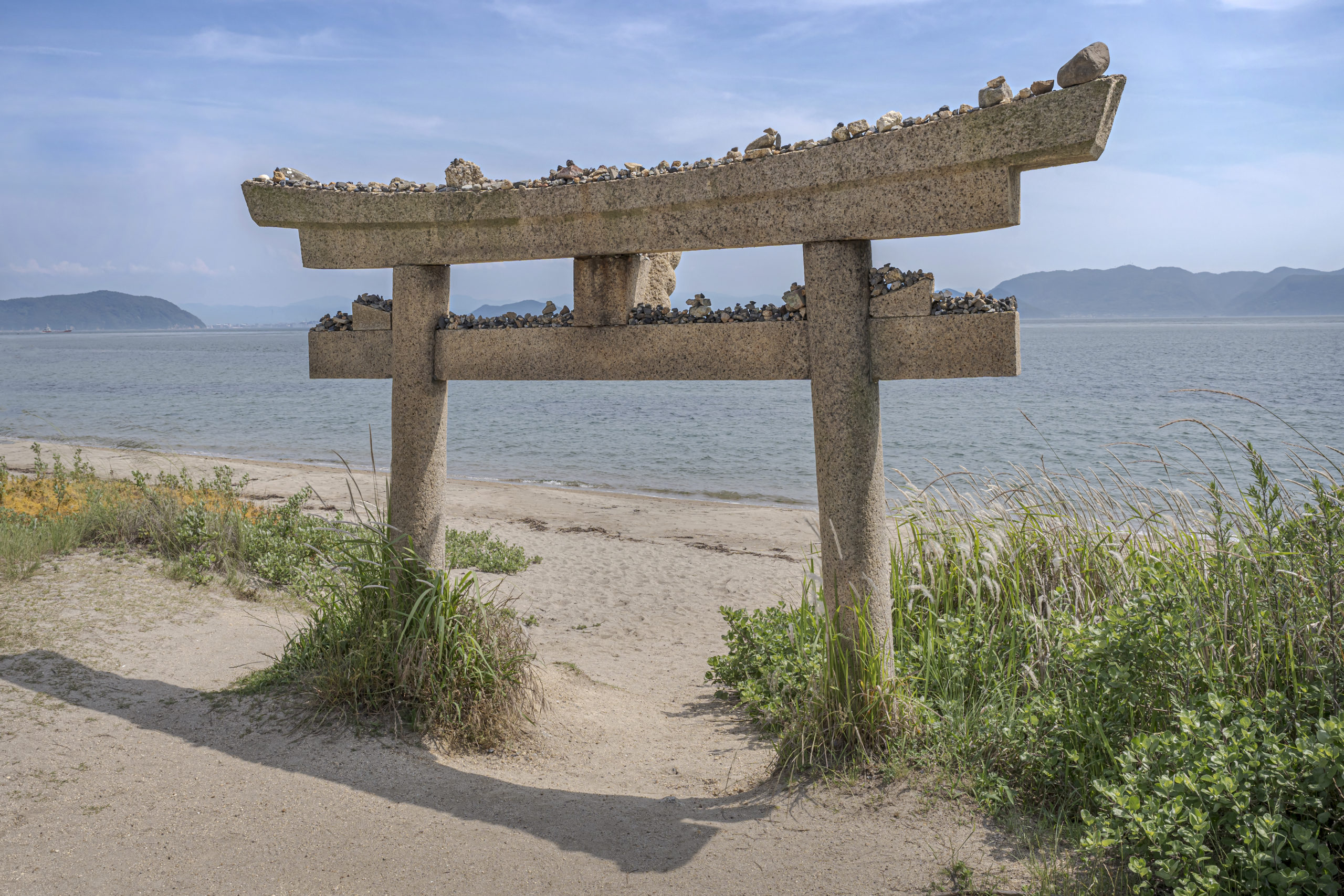Naoshima, Japan, floats in the Seto Inland Sea like an anomaly. This small 8 km² island was home to foundries and chemical plants until the 1990s. Today, tourists disembark from the ferry to see Monet paintings in an underground museum and a giant Kusama pumpkin on a pier. The Benesse Art Site project, launched by billionaire Soichiro Fukutake and architect Tadao Ando, has transformed this industrial patch of land into a global art destination. The local population, which dwindled from 8,000 to 3,000 in a few decades, has seen their island reborn thanks to visitors who come to contemplate artworks rather than factory chimneys.
Contemporary Art Facing the Inland Sea
Naoshima’s story begins with a stark observation: the island was emptying out. Young people were leaving, factories were closing, and traditional houses were falling into disrepair. In 1989, Fukutake decided to establish a cultural centre for children on the island. The project quickly evolved into something more ambitious. Tadao Ando designed buildings that disappear into the landscape, dug into the earth or blended into the topography.
The concept operates on a simple principle: art is not confined to white boxes but engages in a dialogue with its environment. Museums are buried to preserve the horizon lines. Artworks take over abandoned traditional houses in the villages. Outdoor installations punctuate the beaches and hills. This approach now attracts 800,000 visitors a year to an island with fewer permanent residents than a small French village.
Critics sometimes point to an artistic gentrification that transforms residents into extras in a backdrop for cultured tourists. Defenders of the project emphasise that without this reconversion, the island would likely be deserted today.
Main Museums and Installations
The Chichu Art Museum remains the main attraction. Buried in a hill, the museum only reveals its concrete geometry from above. Inside, five of Monet’s Water Lilies occupy an oval room lit solely by natural light. James Turrell has created three spaces of light perception. Walter De Maria presents a black granite sphere in a monumental staircase. Entry is expensive, and reservations are mandatory, especially during peak season.
The Benesse House Museum combines a museum and a luxury hotel. Guests can wander through the galleries after official closing hours. The main building exhibits works by Basquiat, Warhol, and Richter. The annexes (Oval, Park, Beach) scatter other pieces within various Ando-designed architectures.
The Art Houses transform traditional homes into immersive installations. Kadoya houses a Turrell LED pool where visitors can immerse themselves in coloured light. Minamidera plunges spectators into complete darkness before a gradual light revelation. Go’o Shrine integrates an optical glass staircase into a Shinto sanctuary. These mini-museums can be visited with a common pass, but queues can be long.
Kusama’s yellow pumpkin on the south beach and its red counterpart near the port have become obligatory selfie spots. More discreetly, the installations at the Lee Ufan Museum are worth a visit for their radical minimalism.

Getting Around and Staying on the Island
Ferries depart from Takamatsu (50 minutes) or Uno on Honshu (20 minutes). Takamatsu offers more connections to major cities. Miyanoura Port welcomes the majority of boats. Honmura, the traditional village, has its own small port.
On the island, cycling remains the ideal mode of transport. Rental shops near the ports offer classic or electric bikes. The island is hilly, and electric assistance helps for reaching the elevated Chichu Museum. A municipal bus connects the main sites, but schedules remain limited. Walking is an option for the more active, taking about 30 minutes between Miyanoura and Honmura.
Accommodation ranges from basic camping to prohibitively priced rooms at Benesse House. Minshuku (family-run inns) offer a good compromise with meals included. A few business hotels near the main port provide functional rooms. Recent guesthouses target backpackers with dormitories and common areas. Booking becomes crucial in summer and during the Setouchi Triennale, held every three years.
Neighbouring Islands in the Art Circuit
Teshima is worth a detour for its teardrop-shaped museum designed by Ryue Nishizawa. The single room houses a permanent installation where water seeps from the floor. The ferry journey from Naoshima takes 25 minutes. The island, more rural than Naoshima, also offers artworks scattered throughout its villages and rice paddies.
Inujima, a former copper island, exhibits installations within the ruins of its refinery. The Seirensho Art Museum reuses materials from the abandoned factory. Small in scale but highly impactful, especially Yayoi Kusama’s mirror labyrinth.
The Setouchi Triennale (next edition in 2025) extends the art circuit to a dozen islands. Shodoshima, Ogijima, and Megijima host temporary and permanent works. The unlimited ferry pass during the festival facilitates intensive island hopping.
Practical Tips and Visit Timing
Absolutely avoid Japanese weekends and public holidays. Museums limit entries, and queues lengthen from 9 am. Golden Week in early May and summer holidays transform the island into a cultural theme park.
Two full days allow you to see the essentials without rushing. Three days, including Teshima, offer a more relaxed pace. A day trip from Takamatsu is possible but can be frustrating – waiting times eat into your schedule.
Expect a significant budget: museum entries between 1000 and 1500 yen each, Art House pass at 1050 yen, minshuku nights around 8000 yen with meals. Benesse House starts at 25000 yen per night. Restaurants on the island charge tourist prices; the convenience store near the port remains the economical option.
Booking Chichu Museum tickets online saves time. Download the Benesse app for maps and schedules. Bring cash, as not all sites accept cards. Museums close on Mondays (except during the Triennale); check calendars. Photography is prohibited in most indoor spaces, so putting away your camera avoids constant reminders.
Hello! I’m Ben Fischer, a travel enthusiast who has journeyed far and wide to bring you unique and inspiring stories. Each destination is a new adventure for me, a chance to explore diverse cultures and share unforgettable experiences.
In my articles, I take you beyond mere descriptions of places. I share the encounters, special moments, and anecdotes that make each trip unique. My writing is an invitation to see the world through my eyes, blending practical tips with personal insights.
As a lifelong traveler, I approach each journey with respect and curiosity, eager to uncover the stories hidden in every corner of the globe.

